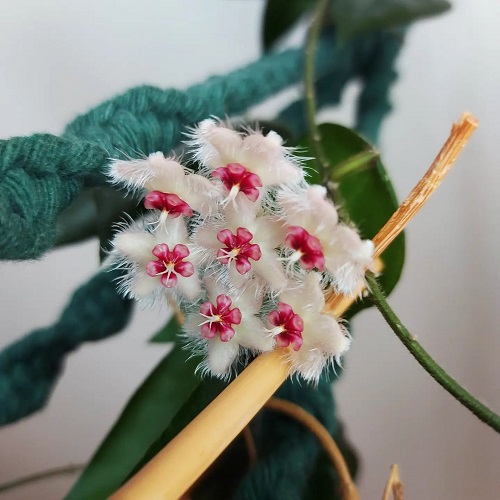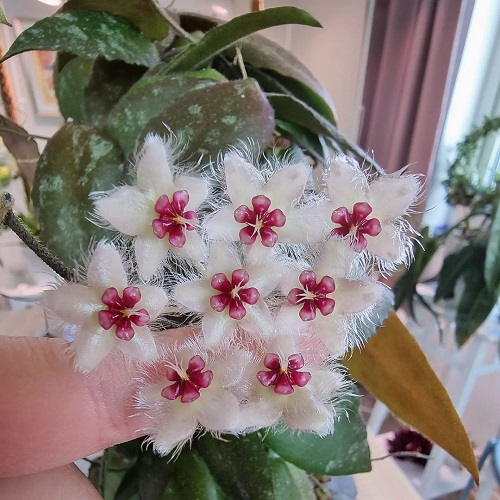Hoya Caudata Sumatra is a cute little plant that you can grow in small pots to display on shelves and coffee tables. Let’s have a look!

If you want a stubby specimen that grows incredibly beautiful flowers, then Hoya Caudata Sumatra is a great choice! Here are all the details on how to grow it.
Check out Amazing Hoya Plant Ideas here
Hoya Caudata Sumatra Information
Hoya Caudata Sumatra, or Hoya Caudata, is a vining epiphyte from the Apocynaceae dogbane family and was discovered in 1883 by Thomas Hoya. This rare wax plant variety produces green-red-tinged foliage covered in a waxy layer and silver speckles. It offers creamy to pink vanilla-scented hairy blooms.
This tropical and terrestrial plant is native to southern Thailand, Singapore, Sumatra, Peninsular Malaysia, and Borneo, where it thrives on stream beds and rocks. The word Caudata in the plant name implies ‘having a tail or caudate.’
Hoya Caudata is ideally grown in hanging baskets as it trails beautifully.
Check out Hoya Joy Growing and Care Information here
Propagating Hoya Caudata Sumatra from Cuttings

The best planting time is summer and early spring.
- Take a 5-6 inches long stem cutting with a node.
- Fill a pot with peat moss and sand, and plant the cutting in it.
- Water well without making the soil soggy.
- Keep the pot in indirect sunlight, and cover it with a plastic bag.
- The roots will emerge in 7-10 days.
Here are Herbs that Grow Best from Cuttings
Propagating Hoya Caudata Sumatra from Seeds

- For propagating Hoya Caudata from seeds, allow the pods to dry on the plant.
- Break the pods to collect seeds, and sow them into an orchid or seed starting mix in a shallow tray.
- Give enough water and indirect sunlight.
- The seeds will germinate in 3-4 weeks. Wait till the new growth emerge to move them into a container.
Here’s the list of free seeds that you have in your pantry
Propagating Hoya Caudata Sumatra from from Leaf
- It is challenging to propagate a plant from the leaf as all leaves are not proficient at forming a healthy adult plant.
- Take a leaf from a healthy, established plant, and cut it off at the node.
- Let it dry or form a callus for two days.
- Dip the leaf petiole in the rooting hormone to stimulate growth (optional).
- Plant it in a pot at an angle of 45 degrees.
- The leaf will develop nascent roots in the soil in a month.
- It will take several weeks when the leaves will increase in height, and you’ll see the first few nodes.
Check out these Romantic Heart Shaped Leaf Plants To Grow Indoors
Requirements for Growing Hoya Caudata Sumatra

Light
Choose a spot that receives indirect or filtered light all day long. It would be a great idea to expose it for 2-3 hours to the mild morning sun, but avoid direct exposure to afternoon light as it can burn the foliage.
While growing indoors, keep Hoya Caudata Sumatra on a south or north-facing window. You can also take the help of fluorescent lighting in the absence of required conditions.
Learn about the Signs that Indicate Your Indoor Plants Need More Sunlight here
Soil
Hoya Caudata appreciates moist soil with good drainage. It will be best to use a mixture of 1/3 perlite, 1/3 peat, and 1/3 orchid mix – you can also add charcoal or fir bark in it. The ideal soil pH ranges from 6.1 to 7.5.
Water
Hoya Caudata Sumatra prefers watering when the topsoil goes a little dry. Do not moisten the soil on a daily basis, as it can lead to root rot. Before watering, check whether the soil is dry or not, and give intervals between watering.
Here are Signs of Overwatering & How to Save an Overwatered Plant
Temperature
Hoya Caudata Sumatra favors a temperature range between 60-95 F (15-35 C). Also, do not expose the plant to high temperatures, as it can burn the foliage. Keep the plant away from drafty windows and doorways in winter.
Humidity
This plant loves high humidity, which ranges from 60-80 %. If you have dry air in the room, use a humidifier or keep the pot a tray filled with water and pebbles.
Check out Ways To Increase Humidity For Houseplants That Work here
Hoya Caudata Sumatra Care

Fertilizer
Feed Hoya Caudata Sumatra with a liquid fertilizer high in nitrogen. When the plant is producing flowers, change the fertilizer with the high phosphorus content. Ensure to fertilize the plant from spring to summer.
Skip feeding Hoya Caudata in fall or winter.
Pro Tip: Add worm castings or compost to give it an all-around boost.
Check out these Effective Homemade Lawn Fertilizers That Are Safe From Hazardous Chemicals
Re-potting
Hoya Caudata Sumatra likes to be in a slightly root-bound state. Re-pot only when you see too many roots popping out of the topsoil. Do this in early spring to summer and use only one size bigger container than the old one.
Pests and Diseases
Be careful of spider mites, scales, thrips, aphids, and mealybugs. When you notice these pests, isolate the plant to prevent its spread. Cut off the infected vines with pruning shears and follow up with an organic insecticide.
Overwatering can lead to root rot.
Here are DIY Insecticidal Soap Recipes for the Garden to Kill Pests
Hoya Caudata Sumatra – Toxicity
The sap of Hoya Caudata Sumatra is mildly toxic and may cause stomach-related issues and skin irritation. Hence keep it away from pets and kids. The best is to plant it in hanging baskets to keep it out of reach.


